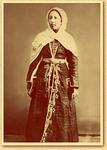 They live in Ingushetia, Chechnya, North-Ossetiya and other regions. They live in Ingushetia, Chechnya, North-Ossetiya and other regions.
Religion: Sunni-muslims
Diaspora: Kazakhstan, Central Asia, Middle East.
Like the Chechens, the Ingush are indigenous to the north slope of the Caucasus mountain range. Both peoples are descendants of the Nakh people.
The main differences between the two peoples arose because of their different experiences with Russian colonization. Another difference is that a bigger proportion of the Ingush were still Christian when Russian influence began towards the end of the 18th c.
The Ingush took little part in the Shamil revolt from 1834-58, whereas the uprising stamped a permanent mark on the Chechens. During the 1860s, when ethnic Russian settlers started pouring into the Caucasus on a large scale, the western Nakh (Ingush) were relatively passive, whereas the eastern Nakh (Chechens) resisted violently. At this point, the Russians started to refer to them as Ingush and Chechens. The rebellious Chechens were driven into the mountains, while the Ingush were encouraged to settle on the plain.
In 1920, Ingushetia was merged into the new "Mountain People's Autonomous Republic, but in 1924 it was hived off as the Ingush Autonomous oblat (AO). In 1934, it was merged with the Chechen AO to become the Chechen-Ingush ASSR.
During the Stalinist puges of the 1930s, Ingush intellectual leaders were slaughtered, the language outlawed, and attempts were made to suppress Muslim traditions. The result, however, was that Muslim and anti-Russian sentiments were strengthened. Collectivisation reinforced these trends.
In the Second World War, when the Nazi Germans neared the Caucasian oilfields, Ingush and Chechens were found on both sides in the war. Because of this lack of loyalty to Soviet power, the Chechens and Ingush (totalling 319,000 and 74,000 respectively) were deported to Siberia and Central Asia and removed from official statistics. The AO was disbanded.
In 1957, the Ingush were rehabilitated and the Chechen-Ingush AO re-established. Re-settlement caused tensions with neighboring peoples (Avars, Dargins and others) that had moved into their villages, and now had to be expelled. During the exile years, the Ingush became almost as fiercely anti-Russian as the Chechens.
In the following decades, despite campaigns against religion, the Ingush clung to Islam. In 1975, it was estimated that - just like the Chechens - half the Ingush population belonged to Sufi brotherhoods. Mosques were reopened in 1978.
Glasnost encouraged the various peoples of the Soviet Union to demand more autonomy, and the Ingush were no exception.
In the turmoil after the August 1991 coup in Moscow, Chechen leaders declared an independent Chechen republic, separated from the Ingush. The republic of Ingushetia was established as part of the Russian Federation.
Chechen independence was a challenge, not only to the Soviet Union, but also to the Russian Federation, of which it was part, and RSFSR President Yeltsin declared emergency rule and sent 1,000 troops which were almost immediately called back. In 1992, Russia sent troops to the region to quell an emerging Civil war between the Ingush and the Ossetians. Chechen leader Dudayev called for a Holy War against Russia, following an incident where these troops crossed the border between Chechnya and Ingushetiya. A disastrous official Russian miltary campaign against the Chechen secessionists lasted from December 1994 until Yeltsin appointee Aleksandr Lebed and Chechen chief of staff Aslan Maskhadov in August 1996 negotiated an agreement to end the fighting. The conflict over Chechnya's status is still unresolved.
The Ingush have not yet developed such a strong national identity as the Chechens. They still tend to identify themselves on a sub-national (tribal or clan loyalties) or supra-national (Muslim faith) level. If the Chechens should succeed in their drive for independence, the Ingush might seek their own homeland as well.
The Ingush have had some conflict with their neighbors to the west, the Ossetians. The root of the conflict is made up of the problems that followed when the Ingush returned from their exile from 1957 onwards, and found that Ossetians had occupied former Ingush land. In 1991, the Ingush claimed that the North-Ossetian capital, Vladikavkaz, should become part of a North-Ingushetian republic. They also argue that the Prigorodnyy region of North Ossetia is their historic homeland. Throughout 1992, there was sporadic fighting in the area, and the conflict has yet to be resolved.
|













 State
State  Nations of Russia
Nations of Russia